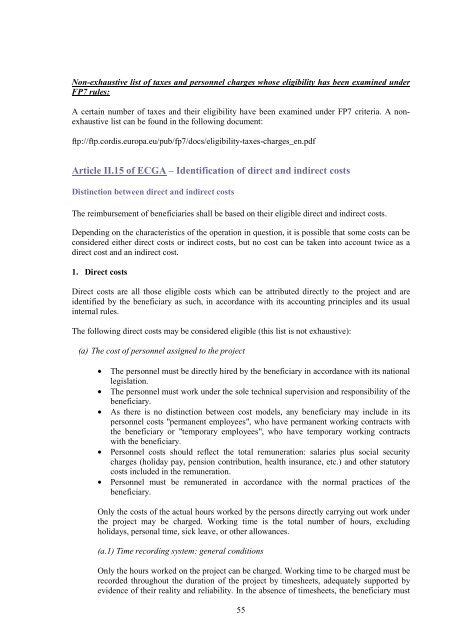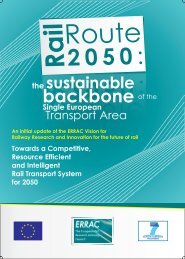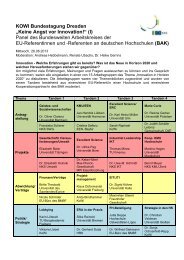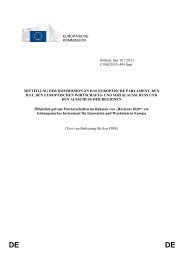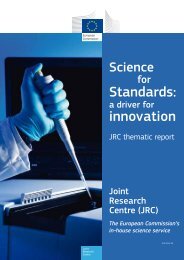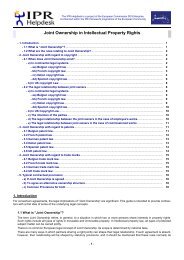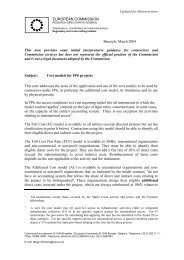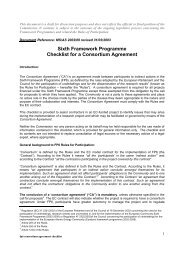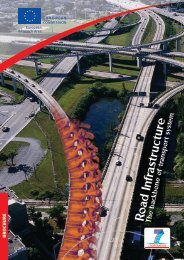Guide to Financial Issues relating to FP7 Indirect Actions - KoWi
Guide to Financial Issues relating to FP7 Indirect Actions - KoWi
Guide to Financial Issues relating to FP7 Indirect Actions - KoWi
You also want an ePaper? Increase the reach of your titles
YUMPU automatically turns print PDFs into web optimized ePapers that Google loves.
Non-exhaustive list of taxes and personnel charges whose eligibility has been examined under<br />
<strong>FP7</strong> rules:<br />
A certain number of taxes and their eligibility have been examined under <strong>FP7</strong> criteria. A nonexhaustive<br />
list can be found in the following document:<br />
ftp://ftp.cordis.europa.eu/pub/fp7/docs/eligibility-taxes-charges_en.pdf<br />
Article II.15 of ECGA – Identification of direct and indirect costs<br />
Distinction between direct and indirect costs<br />
The reimbursement of beneficiaries shall be based on their eligible direct and indirect costs.<br />
Depending on the characteristics of the operation in question, it is possible that some costs can be<br />
considered either direct costs or indirect costs, but no cost can be taken in<strong>to</strong> account twice as a<br />
direct cost and an indirect cost.<br />
1. Direct costs<br />
Direct costs are all those eligible costs which can be attributed directly <strong>to</strong> the project and are<br />
identified by the beneficiary as such, in accordance with its accounting principles and its usual<br />
internal rules.<br />
The following direct costs may be considered eligible (this list is not exhaustive):<br />
(a) The cost of personnel assigned <strong>to</strong> the project<br />
• The personnel must be directly hired by the beneficiary in accordance with its national<br />
legislation.<br />
• The personnel must work under the sole technical supervision and responsibility of the<br />
beneficiary.<br />
• As there is no distinction between cost models, any beneficiary may include in its<br />
personnel costs "permanent employees", who have permanent working contracts with<br />
the beneficiary or "temporary employees", who have temporary working contracts<br />
with the beneficiary.<br />
• Personnel costs should reflect the <strong>to</strong>tal remuneration: salaries plus social security<br />
charges (holiday pay, pension contribution, health insurance, etc.) and other statu<strong>to</strong>ry<br />
costs included in the remuneration.<br />
• Personnel must be remunerated in accordance with the normal practices of the<br />
beneficiary.<br />
Only the costs of the actual hours worked by the persons directly carrying out work under<br />
the project may be charged. Working time is the <strong>to</strong>tal number of hours, excluding<br />
holidays, personal time, sick leave, or other allowances.<br />
(a.1) Time recording system: general conditions<br />
Only the hours worked on the project can be charged. Working time <strong>to</strong> be charged must be<br />
recorded throughout the duration of the project by timesheets, adequately supported by<br />
evidence of their reality and reliability. In the absence of timesheets, the beneficiary must<br />
55


